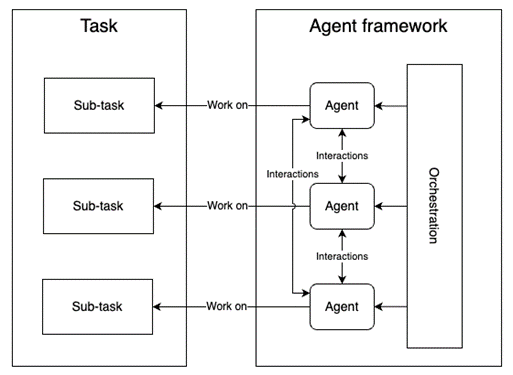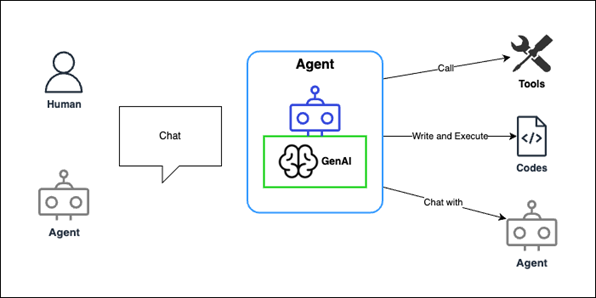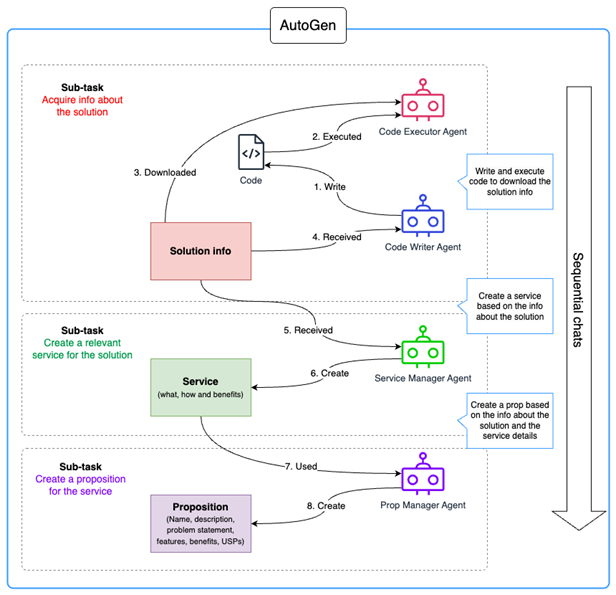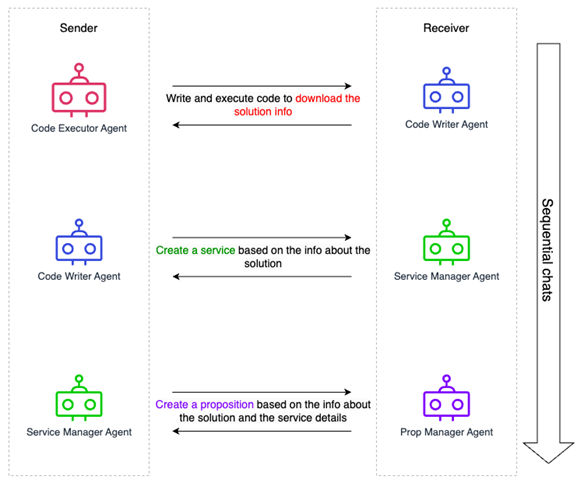Generative AI holds significant power, enabling tasks such as information collection, summarisation, analysis, and content generation. While typically each GenAI prompt addresses a single task, real-life automation often requires multiple sub-tasks, iteration, interaction, and orchestration of these sub-tasks. Sometimes, human involvement is also necessary.
GenAI agentic automation is the solution for achieving such complex objectives. A GenAI agent abstracts the GenAI capabilities and supports iteration, as well as interactions with other agents and/or humans. To automate a task, different agents for different sub-tasks work together to complete the task. This approach is known as GenAI agentic automation. GenAI agentic automation is a concept that can be implemented by various GenAI agent frameworks. Although different frameworks may have different implementations, they all essentially enable the use and orchestration of agents as discussed above to automate tasks.
High level GenAI agentic automation architecture

AutoGen Agent Framework
This article introduces one of the GenAI agent frameworks in the industry named AutoGen. AutoGen offers a unified multi-agent conversation framework, serving as a high-level abstraction for utilising foundation models. It features customisable and conversable agents that integrate large language models (LLMs), tools, and human input through automated agent chat. By automating conversations among multiple capable agents, AutoGen enables the autonomous or human-assisted performance of complex tasks, including those requiring tool usage via code.
Functionalities of an agent in AutoGen

This framework simplifies the orchestration, automation, and optimisation of complex LLM workflows. It enhances the performance of LLM models while addressing their limitations. AutoGen enables the creation of next-generation LLM applications based on multi-agent conversations with minimal effort.
Let’s dive deeper into AutoGen via an example that creates a proposition for a new solution. Creating a proposition is the task in this example. It can be divided into three sub-tasks as below.
- Acquire information of the solution.
- Create a relevant service for the solution.
- Create a proposition for the service.

Please note for demo purpose, this example is simplified. AutoGen can support more sophisticated tasks required for your specific needs.
In reality, to create a new proposition, you may:
- Have a service manager who is responsible for finding and acquiring information about the solution.
- After gathering this information, the service manager creates a service for the solution. This service may include details such as what the company will do, how it will help the customer, and the benefits for the customer.
- Once the service is defined, a proposition manager develops a proposition for the service. This proposition may include the name, description, problem statement, target audience, features, benefits to the customer, and the company's unique selling points (USPs).
Proposition creation process

How AutoGen performs the same tasks to automate the proposition creation
Firstly, a task is divided into sub-tasks similarly for AutoGen.
Sub-task: Acquire info about the solution
Assume that the information of the solution can be found from a website. The information can be obtained via an agent. In this example, it is assumed that there is no existing tool for us to download the information from that website. You can even use agent to help you write code to download the information from the website. So for this sub-task, you will have Code Writer Agent for writing code and a Code Executor Agent for running the code to download the information about the solution.
Sub-task: Create a relevant service for the solution
For this sub-task, there is a Service Manager Agent that helps you create a service related to this solution. This service may include information about what it provides, how it helps and the benefits it provides.
Sub-task: Create a proposition for the service
A Prop Manager Agent is there to help you create the proposition. The proposition will include the name, description, problem statement and features of the proposition, benefits to customer and the USPs of the company.
Proposition creation process with AutoGen

These agents are orchestrated via sequential chats to work on the sub-tasks and provide the required deliverables.

Finally, the Prop Manager Agent will create a proposition based on the information about the solution and the service created by the Service Manager Agent.
Sample proposition created via agentic automation
Below is the proposition for AI red-teaming created via the GenAI agentic automation approach demonstrated above.
Proposition: SafeguardAI+
Description: SafeguardAI+ is a comprehensive service that offers organisations the opportunity to implement Red Teaming for generative AI models to ensure the thorough testing of potentially harmful behaviour. By provoking AI models to exhibit problematic behaviours, biases, and vulnerabilities, businesses can proactively identify and address issues to strengthen the safety and security of their AI models. This service provides a systematic approach to stress-testing and fortifying AI models, allowing organisations to innovate with confidence in the field of generative AI.
Problem Statement: Organisations are increasingly utilising generative AI models, but the potential risks of leaks of sensitive data, biased content, or inaccuracies pose significant threats to their operations and reputation.
Target Audience: Enterprises and organisations looking to implement generative AI models and ensure their safety and security.
Features:
- Red Teaming for generative AI models
- Thorough testing for potential harmful behavior
- Identification and mitigation of biases and vulnerabilities
- Systematic approach to strengthen AI model safety and security
Benefits to Customers:
- Enhanced safety and security of generative AI models
- Proactive identification and mitigation of biases and vulnerabilities
- Confidence in innovating with generative AI technologies
Airwalk Reply USPs
- Expertise and track record in securely integrating disruptive technologies into highly regulated organisations
- Tailored approach to address specific AI adoption challenges in security for individual needs
- Multidisciplinary approach combining AI and platform business functions expertise
- Systematic approach aligned with the latest strategy and technology innovations
More from AutoGen
The example above demonstrates how to use sequential chat to automate the development of a simplified proposition. You should have recognised the power of GenAI agentic automation and AutoGen. While sequential interactions are useful, they are limited to problems that do not require dynamic interactions among different agents. However, AutoGen offers additional capabilities such as multi-agent collaboration and nested chats. These features enable various chat patterns, allowing for countless use cases inspired by your innovative ideas. For example, you can use multi-agent chats for tasks like stock and market analysis, information retrieval, content generation, and creating code to visualise data. Discover more at AutoGen’s website.
Link to the code of the proposition creation automation example can be found here.
AI Enablement and Acceleration Services Learn more






